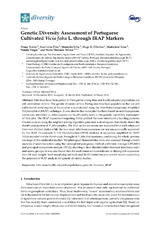Mostrar el registro sencillo del ítem
Genetic Diversity Assessment of Portuguese Cultivated Vicia faba L. through IRAP Markers
| dc.contributor.author | Tomás, Diana | |
| dc.contributor.author | Dias, Ana Luisa | |
| dc.contributor.author | Silva, Manuela | |
| dc.contributor.author | Oliveira, Hugo R. | |
| dc.contributor.author | Suso, María José | |
| dc.contributor.author | Viegas, Wanda | |
| dc.contributor.author | Veloso, María Manuela | |
| dc.date.accessioned | 2017-11-09T08:24:35Z | |
| dc.date.available | 2017-11-09T08:24:35Z | |
| dc.date.issued | 2016 | |
| dc.identifier.uri | http://hdl.handle.net/10396/15380 | |
| dc.description.abstract | Faba bean have been grown in Portugal for a long time and locally adapted populations are still maintained on farm. The genetic diversity of four Portuguese faba bean populations that are still cultivated in some regions of the country was evaluated using the Inter Retrotransposons Amplified Polymorphism (IRAP) technique. It was shown that molecular markers based on retrotransposons previously identified in other species can be efficiently used in the genetic variability assessment of Vicia faba. The IRAP experiment targeting Athila yielded the most informative banding patterns. Cluster analysis using the neighbor-joining algorithm generated a dendrogram that clearly shows the distribution pattern of V. faba samples. The four equina accessions are separated from each other and form two distinct clades while the two major faba bean accessions are not unequivocally separated by the IRAP. Fluorescent In Situ Hybridization (FISH) analysis of sequences amplified by IRAP Athila revealed a wide distribution throughout V. faba chromosomes, confirming the whole-genome coverage of this molecular marker. Morphological characteristics were also assessed through cluster analysis of seed characters using the unweighted pair group method arithmetic average (UPGMA) and principal component analysis (PCA), showing a clear discrimination between faba bean major and equina groups. It was also found that the seed character most relevant to distinguish accessions was 100 seed weight. Seed morphological traits and IRAP evaluation give similar results supporting the potential of IRAP analysis for genetic diversity studies. | es_ES |
| dc.format.mimetype | application/pdf | es_ES |
| dc.language.iso | eng | es_ES |
| dc.publisher | MDPI | es_ES |
| dc.rights | https://creativecommons.org/licenses/by/4.0/ | es_ES |
| dc.source | Diversity 8(2), 8 (2016) | es_ES |
| dc.subject | Faba bean locally adapted populations | es_ES |
| dc.subject | Genomic diversity | es_ES |
| dc.subject | IRAP | es_ES |
| dc.title | Genetic Diversity Assessment of Portuguese Cultivated Vicia faba L. through IRAP Markers | es_ES |
| dc.type | info:eu-repo/semantics/article | es_ES |
| dc.relation.publisherversion | http://dx.doi.org/10.3390/d8020008 | es_ES |
| dc.rights.accessRights | info:eu-repo/semantics/openAccess | es_ES |

